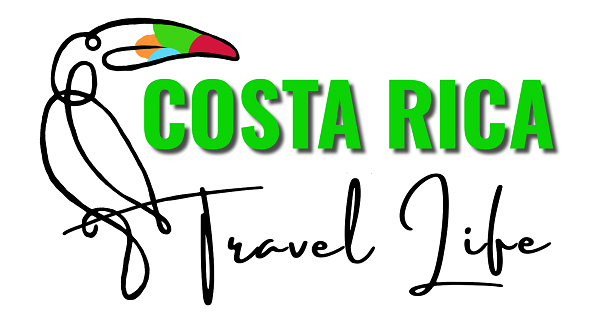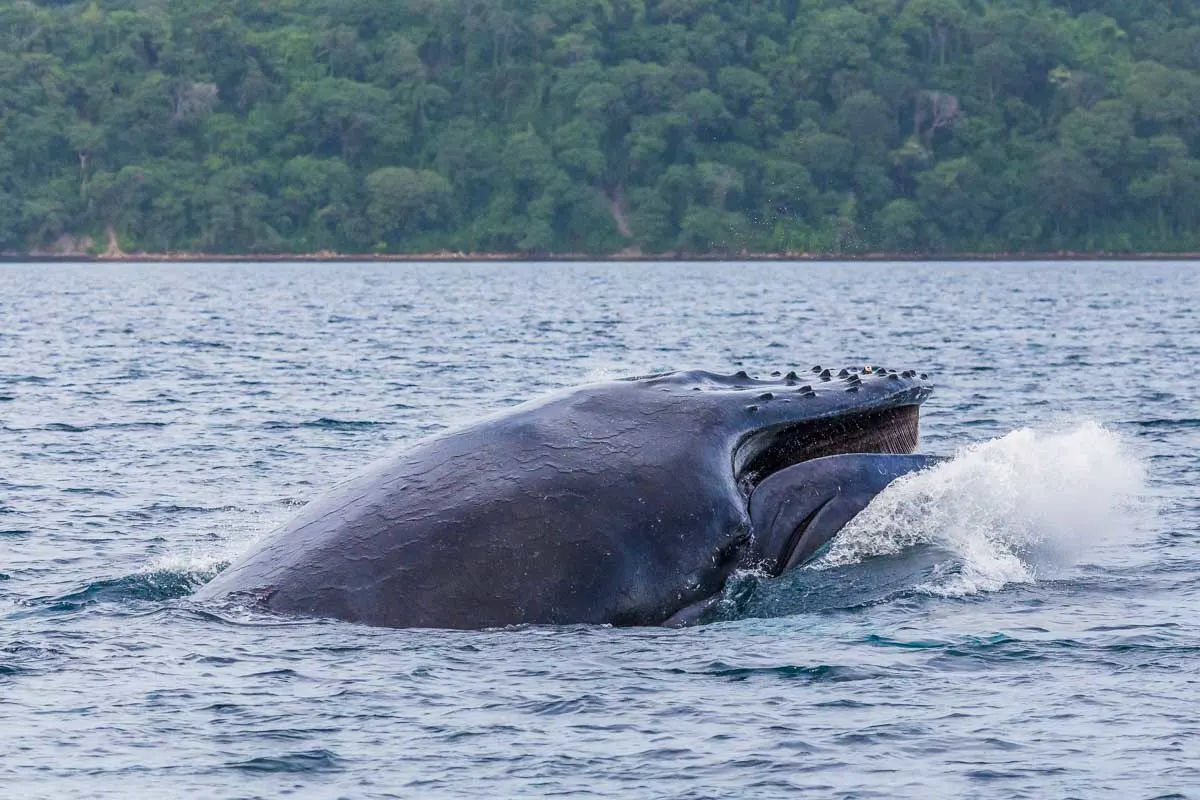This blog may contain affiliate links. Read our disclosure policy for more info.
Spotting wildlife is one of the biggest draws for travelers visiting Costa Rica. Sure, it’s known for exotic birds, sloths, and monkeys, but did you know this is also a prime whale watching location? Costa Rica’s Pacific Coast is about as popular for whale migration as New York rush hour traffic, so if you visit at the right time of year, you’re guaranteed to see some amazing marine life!
Uvita is one of the best places for whale watching in Costa Rica. It’s also close to Marino Ballena National Park which has thousands of acres of protected land that is perfectly hospitable for humpback whales, Bryde’s whales, pilot whales, and more. There is even a sandbar here that is in the shape of a whale tail! It’s meant to be, right?
Since Uvita is so popular for whale watching, it can be overwhelming to decide when to go or how to best prepare for your trip. Not to worry friends! This post will highlight some of our favorite tours, best times of year to visit, and basically everything we learned when we went whale watching in Uvita.
We have been whale watching all over the world, and can easily say Uvita is the most impressive location. To help you plan this grand adventure, we put together this guide on 10 things to know before you go whale watching in Uvita, so you can enjoy this incredible experience too!
1. About whale watching in Uvita

Uvita is undoubtedly the best place for whale watching in Central America. It is actually one of the few places in the world where you can see whales migrate over two different seasons a year! Over 10,000 whales travel to Costa Rica annually to feed, breed, and give birth in its warm waters.
The most common whale migrating through is the humpback whale. Uvita is such a unique location for humpback whale watching tourism because it has whales migrating from both the Northern and Southern Hemispheres. Most iconic whale watching locations, like Mexico or Ecuador, only receive whales from their respective hemisphere, but Costa Rica’s central location can host both!
The first part of the whale watching season is during the Northern Hemisphere’s winter season (December to March) when whales from North America’s Pacific Coast migrate south. However, the really impressive journey is the Antarctic whales from Argentina and Chile that migrate over 8,300 kilometers (5,157 miles) to reach Costa Rica’s warm waters. This is the longest mammal migration pattern ever recorded!
While there are actually 34 different types of whale and dolphin species that will pass through Costa Rica’s waters, you will most frequently see humpback whales and Bryde’s whales. Adult Bryde’s whales can be anywhere between 12-16 meters (40-55 feet), and humpbacks can be up to 18 meters (60 feet) and weigh up to 40 metric tonnes (44 US tons). It’s common to see them breaching (jumping out of the water), slapping their tail on the water, or blowing water from their blowhole, which makes it easy to spot them when on a whale watching tour!
Uvita is a great spot for whale watching due to its warm and accommodating waters which serve as excellent spots for mating and feeding for these gentle giants. Marino Ballena National Park protects 13,000 acres (5,260 hectares) of ocean and 15 kilometers (9 miles) of coastline and is home to the largest coral reef in Central America. In regards to the marine ecosystem, Marino Ballena is a cozy paradise for wildlife! It is also easy to access from Uvita, making it easy to enjoy this unique outdoor haven.
2. When is whale watching season in Uvita?

As I mentioned earlier, whale watching is one of the best things to do in Uvita because it has such a long season. While it seems like it’s almost a year-round activity, the high season to spot some whales is from December to March and July to November with the peak being between August and early October.
Visiting from December to March is when you will see the Northern Hemisphere whales. This is also Costa Rica’s dry season, which might make it an overall more enjoyable experience! Visiting from July to November will bring the Southern Hemisphere whales, and even though it is the rainy season, the skies usually clear up in the afternoon so you won’t get too wet. Plus, the rainy season has fewer tourists, which means a more intimate tour for you!
Most of the tour providers will still run tours year-round and don’t always guarantee whale sightings. So, to get the most out of your money, I suggest only booking these tours if you’re visiting during high migration season! Luckily that is about nine months of the year in Uvita so you have a good shot of spotting one.
Related Read: While you’re visiting, check out some of our favorite restaurants in Uvita.
3. What is the best month to go whale watching in Uvita?

While the whale watching season extends for so long, there are definitely high points to see the most whales or other wildlife.
If you’re hoping to visit during the dry season, the best months to spot whales are January and February. This is when the Northern Hemisphere Humpbacks have migrated south and are hanging out in the warm waters, mating, and giving birth. While you still might see them during the shoulder months of December and March, it’s more frequent to have daily sightings of whales during January and February.
However, the most active months for Humpback whales are in August and September. Uvita actually holds a whale festival during this time of year because there is so much whale traffic! The Southern Hemisphere whales finish their long journey and will relax in the warm waters through October. Visiting this time of year is also a great time to see nesting turtles, migrating dolphins, and the luscious green jungle that is astounding in the rainy season!
Spotting whales in their natural environment is nothing shy of incredible. People often wonder if whales breach or slap their tails more during specific seasons – and the short answer is, yes. You might see whales breach during breeding season to attract a potential mate more so than you would during feeding season.
If your goal is to see some baby whales, visiting during breeding season is your best bet since newborns will stick close to their mothers for about a year to nurse. Whales have an 11.5-month gestational period, so the babies made during last year’s breeding season should be newborns around the same time the following year!
4. What time of day is best for whale watching in Uvita?

The best time of day to spot whales on a tour is the morning! While whales can be active throughout the entire day, their daily routine is somewhat unpredictable so you truly have a chance to see them at any time.
However, the ocean is typically calmer in the morning, which makes it a more enjoyable experience for those going on a whale watching tour like this one. The calmer waters and clear skies make for better viewing (you might be able to see the whales from further away), plus you have less of a chance for motion sickness and you can avoid the heat of the day.
Most tours have multiple departure times throughout the day, so you can choose what time works best for your schedule and still have a good shot at spotting these magnificent creatures!
Related Read: If you’re looking for more ways to splash around, check out our guide on visiting Uvita Waterfall.
5. What are the best whale watching tours in Uvita?

Combo Tour Marino Ballena National Park
The best whale watching in Uvita takes off from the coast of Marino Ballena National Park. So not only do you get to see the amazingly large whales, but this tour also lets you explore this beautiful national park, and if weather permits, you’ll get to snorkel off its coral reef-filled shore!
This 3-hour experience is aptly called the “combo tour” because you get a little bit of everything! You’ll meet up with the tour group in Uvita and head straight to Marino Ballena National Park. Entrance to the park is included, and you’ll get to walk along its sprawling coastline and see the famous “whale tail” sandbar. This park is unassumingly charming, and I love that the surrounding ocean is part of its conservation efforts.
You will board the boat and head into the water to search for wildlife. If you book this tour during migration season, however, you won’t have to search too hard! This area is known for its mass amount of whale sightings (including the babies!) as well as spotting bottlenose dolphins, turtles, and various exotic birds.
I was anticipating seeing wildlife on this tour, but I didn’t expect to see the variety of animals that we did! Obviously, the whales were the highlight, but I was also so pumped when the dolphins came swimming right next to the boat!
If you book this tour during the warm months (December to March) you’ll even have the chance to snorkel through these wildlife-filled waters! I was a little skeptical about snorkeling while 50-foot whales could be swimming around, but the guides are vigilant about safety so I never felt uneasy in the water. It actually made the whole experience even more astounding!
This is a great whale watching excursion out of Uvita. It includes entrance to the national park, snorkeling equipment, safety equipment on the boat, and your wonderful guides! Pack your bathing suit and camera to capture this experience (and some sunscreen and snacks!). This tour departs at 8:30 am or 1 pm and is $95 USD.
You can reserve this 3-hour whale-watching experience online here!
Whales and Dolphins Watching Tour From Uvita
This whale watching tour out of Uvita is similar to the previous tour listed, but it only has a morning start time and a maximum capacity of 15 travelers. We personally love smaller tours because you usually get more of an intimate experience and can ask more questions with the guide, plus you won’t have to fight a large crowd to see marine life which is especially convenient on a whale watching tour.
Commencing the tour by visiting Marino Ballena National Park, you can start spotting wildlife right off the boat. This national park is full of life! While we visited, we saw sloths, iguanas, and monkeys, which set a good tone for the day and made us even more hopeful to see the whales!
Our small group boarded the boat from the national park and took off into the ocean, where we spent time spotting whales, dolphins, and turtles! One of the highlights of this tour was our incredible guides, who not only pointed out wildlife from far away but gave us so much information that I practically felt like a marine biologist by the end.
The tour ends with a fresh fruit snack and some free time to explore the national park or snorkel through the reef, which was the perfect ending to a relaxed and enjoyable tour!
This experience lasts 3 to 4 hours and is $99 USD per person. It includes transportation to and from the national park, entrance fees, the boat ride, guides, snorkel equipment, and snacks! Be sure to book this experience in advance, because it is likely to fill up during peak whale-watching season.

One Day Whale Watching From San Jose
While there are some great places to stay in Uvita, you can still catch a whale watching tour even if you’re not staying in town! In fact, if you’re limited on time I recommend this day tour out of San Jose. That way you can experience the awe-inspiring whale watching trip and still have time for other epic Costa Rica activities!
San Jose is about 3.5 hours from Uvita, which is definitely doable on a day trip, and taking a tour makes it way more convenient for you. This tour will pick you up from your San Jose hotel and transport you along the scenic route to Uvita, stopping for breakfast along the way. They provide everything you’ll need for the day, so you really don’t have to worry about any of the details!
Once you reach Uvita, you’ll have two hours on a speed boat to spot whales and other unique marine life! The guides do a great job at finding whales and getting the boat as close as safely possible so you can get a good look at these extraordinary creatures. It will be an experience to remember for a long time!
After your whale watching tour, you’ll start back to San Jose, but stop for lunch before you head out! This tour is scheduled to last all day due to the long travel time, but we think it’s totally worth it. It includes roundtrip transportation, the boat and safety equipment, your amazing guide, and meals.
If you have limited time in Costa Rica, we think this is the best way to see whales! You can reserve this tour for $252 USD when you book online here!
6. Are Uvita whale watching tours eco-friendly?
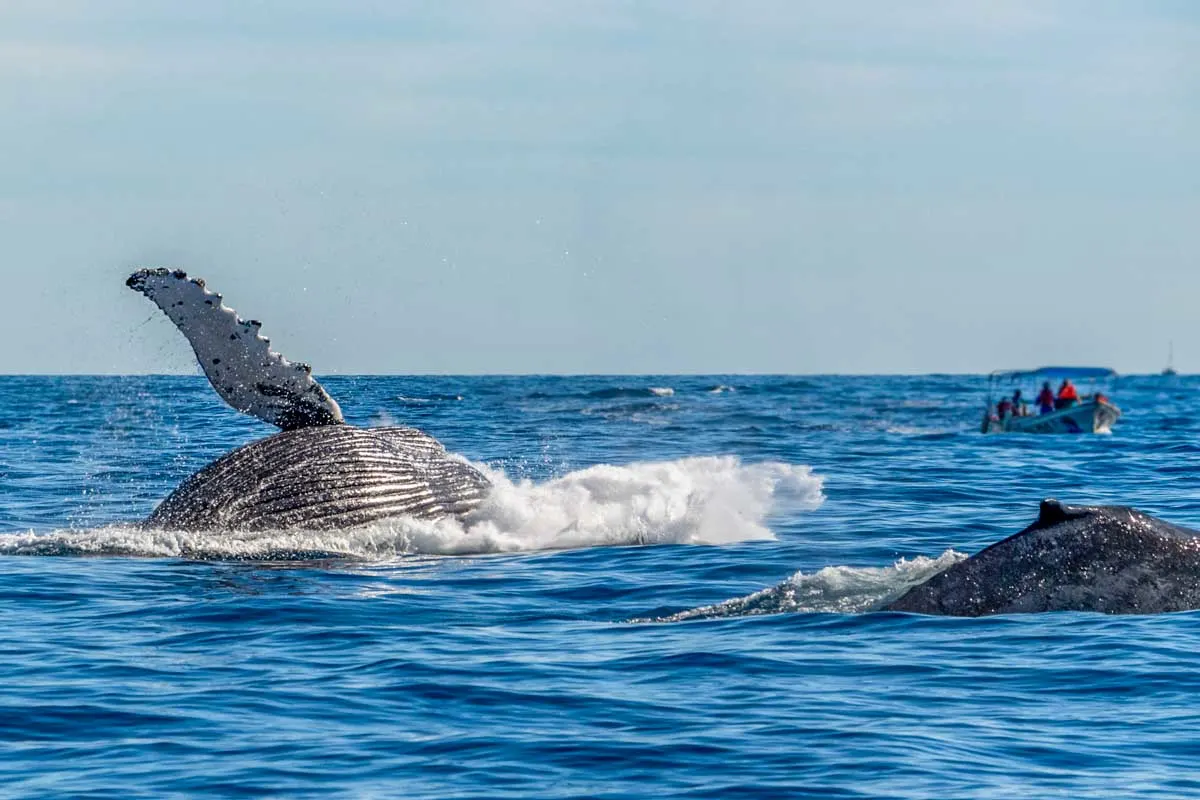
Luckily, most tour operators understand how unique and fragile an ecosystem Costa Rica has, and they take sustainability very seriously! The beautiful thing about whale watching in Uvita is that it’s in the protected Marino Ballena National Park, so any negative ecotourism practices are not tolerated in this area.
All of the tour operators listed in this post keep sustainability and conservation at the forefront of their practices. They do so by collaborating with conservation initiatives, minimizing waste on tours, and respecting the natural environment.
Local tourism companies in Costa Rica have a greater awareness of conservation efforts than most tourists because they are so familiar with the delicate ecosystem. And if their business practices tarnish the beautiful environment, they are out of work, so no one wants to lapse on conservation here!
Related Read: To ensure you’re traveling sustainably, we’ve picked out the best ecolodges in Costa Rica. There are locations all over the country and for every budget.
7. Can you see other wildlife on a Uvita whale watching tour?

Humpback whales are definitely the star of the show on these tours, but there is truly so much wildlife you can see! The most common animals you’ll see (besides whales) are dolphins and turtles. Dolphins follow similar migration patterns as whales, and they are often interactive and playful with the boats!
Turtles nest on the shores between March and November, so you’ll be likely to see a large variety of turtle species during the rainy season.
You will also likely see marine birds (like pelicans, herons, and boobies), sting rays, and unique tropical fish while snorkeling. While visiting the Marino Ballena National Park, you’ll likely see land animals like sloths and monkeys, too.
8. Are the Uvita whale watching tours suitable for kids?

Yes, Uvita whale watching tours are totally kid-friendly! This is actually a super fun and memorable activity for children. I must say, every time I’ve had kids on a whale watching tour I get swept up in their genuine excitement whenever they see an animal!
All the tours on this list have discounted fares for children and infants are free. The tours are very safe, with life jackets and room to walk around on the boats, so kids can wander and be amazed by the whales, too! I think whale watching tours are one of the best family-friendly tours in Costa Rica.
9. What should you wear/bring whale watching in Uvita?

Depending on the time of year you take a whale watching tour, your packing list might change a bit. I always recommend wearing a bathing suit with layered clothes over it, as many of these tours have time for snorkeling and swimming. You should also wear comfortable shoes, reef-safe sunscreen, and a hat to protect you from the sun.
The dry season (December to April) is a bit warmer and sunnier, so don’t skip out on sun protection if you’re visiting this time of year! The rainy season is often still warm but can be wet, so bring a light sweater/rain jacket so you don’t get chilly from the sea breeze. I also recommend bringing cash for tips, as your boat crew is doing a lot of work to provide this amazing experience for you!
Oh, don’t forget your camera! You will certainly want to capture this incredible experience and hopefully snap a photo of a whale jumping out of the water!
10. Is whale watching in Uvita worth it?
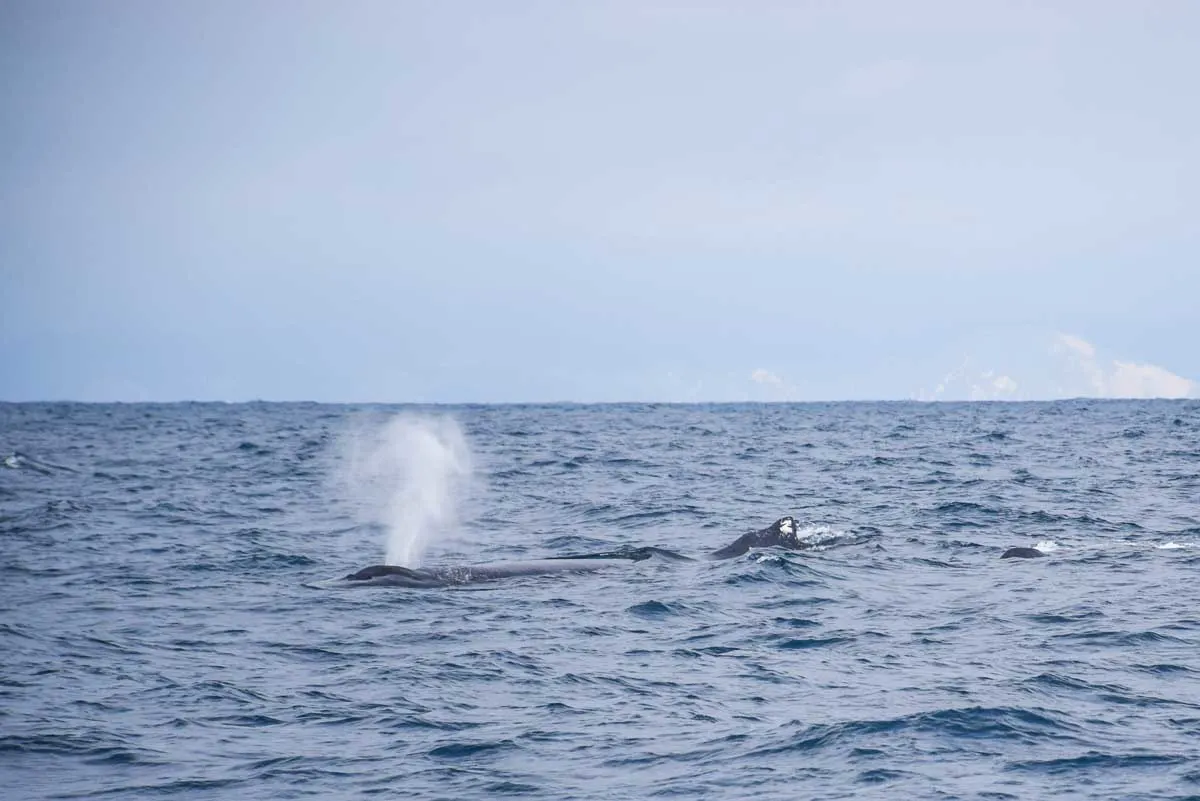
Whale watching in Uvita is 100% worth it! This is one of the best whale watching spots in the world, so it is a no-brainer to book a tour while visiting Costa Rica.
We went on our tour in mid-January, which is probably one of the best times of year to go. The bay was literally filled with whales, to the point that we saw multiple whales at the same time! It was incredible and I hope every traveler can have this epic experience as well!
Where to Stay in Uvita, Costa Rica

When it comes to choosing the right place to stay in Uvita for you, location is essential. For example, those without a car will most likely want to stay near the national park, whereas those with a vehicle can choose to stay further out. If you would like more info on the different areas, be sure to check out our where to stay in Uvita blog.
Below are a few of my favorite hotels in all the different areas around Uvita and in all budgets.
Hostel Cascada Verde – $
For budget travelers, Hostel Cascada Verde is a top choice. The reviews of this hostel are fantastic. The location is on the inland side of town, meaning it’s a fair walk to the national park. However, it is right across from Uvita Waterfall and Uvita Beer Garden in a quiet area surrounded by lush forest.
Rates start at $30 USD for a one-night stay. You can check availability and make a reservation online here on Booking.com or here on HostelWorld.
Bungalows Ballena – $$
If you’d prefer to be close to the national park, Bungalows Ballena is only a 1-minute walk from the entrance to the park. This small hotel offers two-bedroom bungalows with full kitchens and bathrooms. It’s perfect for families, and they also have a pool. We stayed here last time we were in town and loved it – having our own little bungalow was convenient and comfortable.
All of the rooms have a patio. There’s also a pool and grill available for guests. Rates begin at $120 USD per night. You can check availability and book online here on Booking.com.
Oxygen Jungle Villas & Spa – $$$
Those looking for luxury have to check out Oxygen Jungle Villas & Spa. This stunning hotel is located in the hills surrounding Uvita and is perfect for those looking for a romantic getaway. The property features spectacular views, an infinity pool, gorgeous rooms, and an included breakfast.
This is one of the most romantic hotels in Costa Rica – especially if you’re planning a honeymoon. Rates typically begin at $400 USD per night. Book online on Booking.com here.
Getting Around Costa Rica

How you choose to get around Costa Rica is one of the biggest decisions you’ll make when planning your holiday here! How you do it depends on your budget, travel style, and comfort level.
Renting a Car
Without a doubt, the number one way to explore Costa Rica is in a rental car. We book rental cars on the Discover Cars website as we have had good experiences with them in the past.
One of the things you need to watch for when renting a car in Costa Rica is the mandatory insurance that the government requires you to have. There are a lot of very cheap rentals that don’t include this mandatory insurance (TPL) in the original booking price, but there are also ones that do. To avoid additional surprise charges when you pick up your rental car, be sure to rent a car that includes the mandatory insurance when you book.
Thankfully, on Discover Cars it’s easy to tell apart the companies that include the mandatory insurance and those that don’t. The trick is you can’t pick any car on their website. In the picture below, you can see this rental car, with pick up in Jaco, includes the TPL. That means the mandatory insurance is included in the price. Any cover you get above that is extra.
Of course, I still suggest getting the full coverage offered by Discover Cars, which covers you even more.
You can browse cars on Discover Cars here.
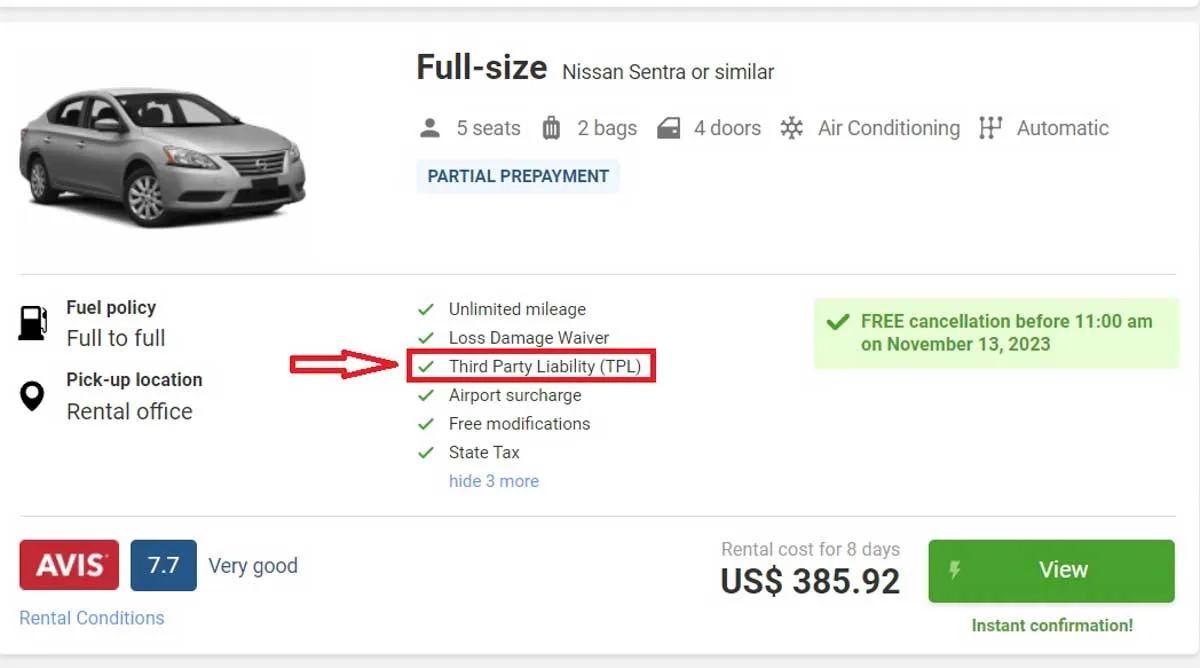
Book Shuttles
If renting a car isn’t in your budget, you don’t feel comfortable driving in Costa Rica, or you just don’t like driving, shuttles are the next best option. There are hundreds of shuttle routes available all over the country, and they are very affordable.
Shuttles in Costa Rica are specifically for tourists and often include pick up and drop off at your selected hotels and airports. The drivers also speak some English, and the vehicles have air conditioning. You’ll also be guaranteed a seat when you book a shuttle (which isn’t the case with the public bus system.)
To get the best price, use the website Bookaway. They compare all the offers and prices of shuttle companies in Costa Rica so you get the best price! Honestly, we have saved so much money using Bookaway!
You can search for shuttles online on Bookaway here.
Public Bus
Lastly, you can use the public bus system. On short journeys, such as from San Jose to La Fortuna or Uvita to Manuel Antonio, this system is great. However, the longer the journey the more hassle and time spent on a bus. It’s undoubtedly best to save the public bus in Costa Rica for short and straightforward trips!
The public buses are definitely the cheapest way to get around Costa Rica, but they are not always very reliable and schedules often change without notice and delays are to be expected. The buses can also be very crowded and hot – so just be prepared!
It’s also good to speak some Spanish if you plan on riding the public bus since most drivers and ticket booth operators don’t speak English.
Pura Vida!
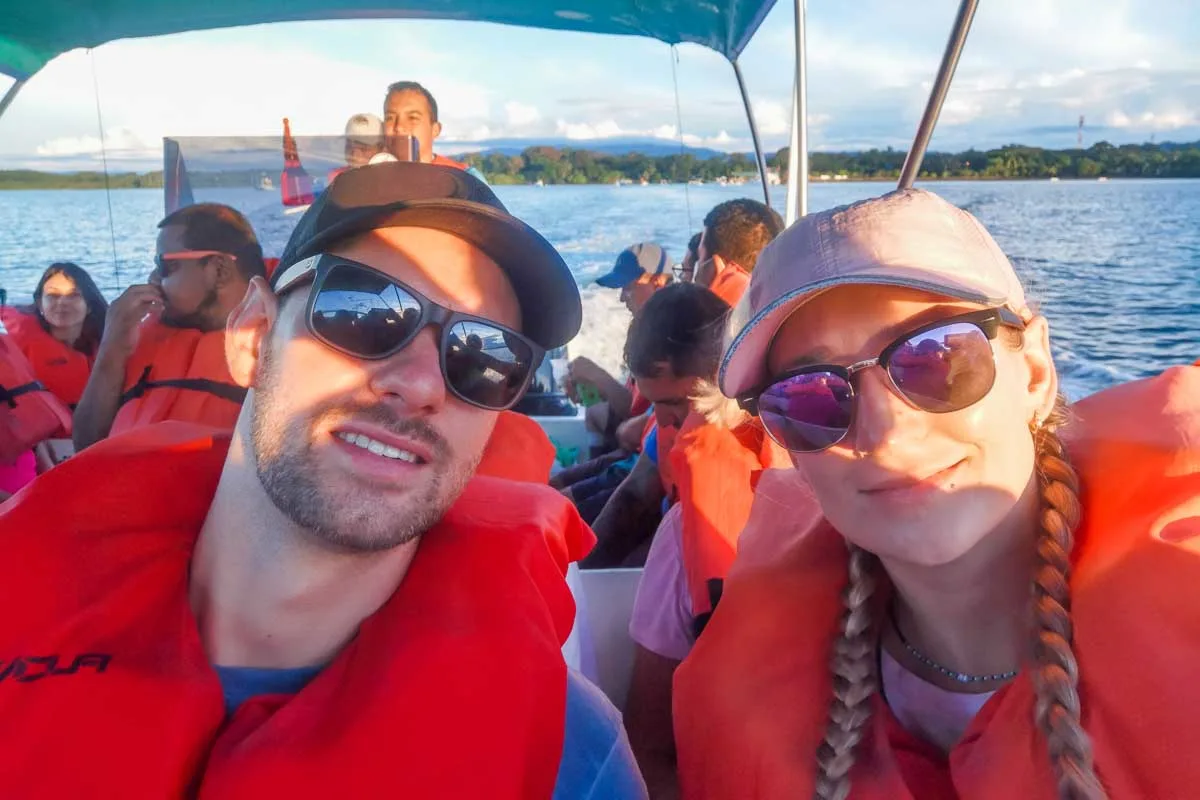
Going whale watching in Uvita is a true treat for nature lovers. You’ll get to see these majestic creatures up close all while exploring the gorgeous Marino Ballena National Park. We hope you’ll love this amazing experience as much as we do!
If this article has been helpful, we’d love for you to read our other Costa Rica blogs. We have traveled around this beautiful country and even lived here, so we have recommendations for the best tours and even our favorite places to eat. We travel back to Costa Rica frequently, so if you’re looking for more suggestions, check out some of our other blogs below.
9 BEST Tours of Costa Rica (Multi-Day Guided Tours) & How to Pick One!
